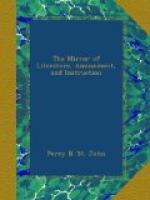The county of Lincoln is eulogized by Fuller as producing superior dogs for the sport; and in Grimsby bull-baiting was pursued with such avidity, that, to increase its importance, and prevent the possibility of its falling into disuse, it was made the subject of an official regulation of the magistracy. It had been practised within the borough from time immemorial, but about the beginning of the reign of Henry VII., the butchers finding it both troublesome and inconvenient to provide animals for the public amusement, endeavoured to evade the requisition; but it was made imperative upon them by the following edict of the mayor and burgesses, which was incorporated into a code of ordinances that were made and agreed to on the 23rd of October, 1499, for the better government of the borough:
“Also, that no Bocher flee or kill no Bull flesche wtin this Burgh, nor that none be brought to sell bot if the Bull be bayted openlye before the Mair and his burgesses, peon of forfeitr. of ev’y default vj s. viij d. Also that the Bochers of this Francheis, and al others that kepe slaughter shopes and kill flesche in this Francheis, to sell, mak onys yerly befor the Mair and his burgesses one bull-bayting, at convenient Tyme of the yere, according to the custom of this Francheis befor usyd, upon peyn of fortur of vj s. viij d.”
In the reign of Charles I. an instance occurs of the violation of this ordinance; and it is formally recorded in the mayor’s court book, that a fine was imposed by the chamberlains on Robert Camm for “killing a bull, and not first baiting him, according to the custom of the corporation.”
These sports were conducted with great cruelty. To make the animal furious, gunpowder was frequently flashed up his nose, and pepper blown into his nostrils; and if this failed to make him show game, his flesh was lacerated, and aquafortis poured into the wound. About sixty years ago a bull was put to the stake at Grimsby; but the animal proving too tame, one William Hall put a spike or brad into his stick, and goaded the poor creature until the blood flowed copiously from several parts of his body; and at length, by continually irritating the lacerated parts, the bull became enraged, and roaring in the extremity of his torture, succeeded in tossing his assailant, to the infinite gratification of his cruel persecutors. It is recorded, to the credit of Mr. Alderman Hesleden, that during his mayoralty, in 1779, the annual exhibition was disallowed: from which time the custom declined, although some instances of this inhuman pastime have subsequently occurred.
Strutt says, that in some of the market towns of England, the bull-rings to which the unfortunate animals were fastened are remaining to the present time. At Grimsby, the arena where this brutal ceremony was performed, is still distinguished by the name of the “Bull-ring.” The ancient stone and ring were removed about thirty years since; but the chain is still in possession of the chamberlains, who pass it annually to their successors; and it is sometimes applied to the purpose of fastening up a gate, when a distress is made on a field belonging to the corporation for rent; but its primitive use is wholly superseded by the abolition of the amusement.




